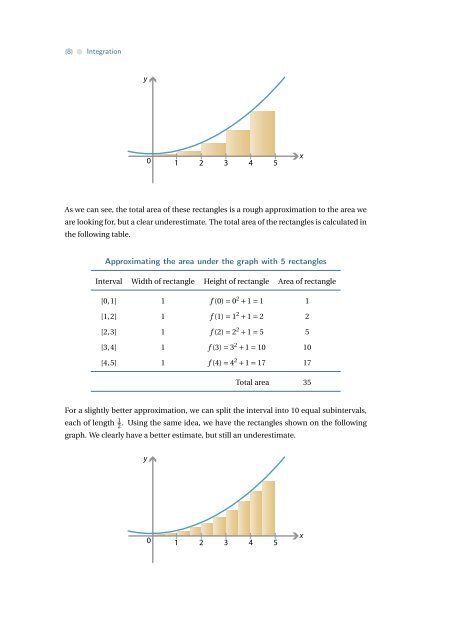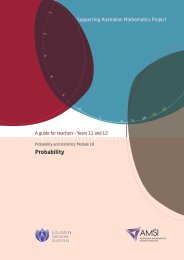Integration - the Australian Mathematical Sciences Institute
Integration - the Australian Mathematical Sciences Institute
Integration - the Australian Mathematical Sciences Institute
You also want an ePaper? Increase the reach of your titles
YUMPU automatically turns print PDFs into web optimized ePapers that Google loves.
{8} • <strong>Integration</strong>y0 1 2 3 4 5xAs we can see, <strong>the</strong> total area of <strong>the</strong>se rectangles is a rough approximation to <strong>the</strong> area weare looking for, but a clear underestimate. The total area of <strong>the</strong> rectangles is calculated in<strong>the</strong> following table.Approximating <strong>the</strong> area under <strong>the</strong> graph with 5 rectanglesInterval Width of rectangle Height of rectangle Area of rectangle[0,1] 1 f (0) = 0 2 + 1 = 1 1[1,2] 1 f (1) = 1 2 + 1 = 2 2[2,3] 1 f (2) = 2 2 + 1 = 5 5[3,4] 1 f (3) = 3 2 + 1 = 10 10[4,5] 1 f (4) = 4 2 + 1 = 17 17Total area 35For a slightly better approximation, we can split <strong>the</strong> interval into 10 equal subintervals,each of length 1 2. Using <strong>the</strong> same idea, we have <strong>the</strong> rectangles shown on <strong>the</strong> followinggraph. We clearly have a better estimate, but still an underestimate.y0 1 2 3 4 5x
















